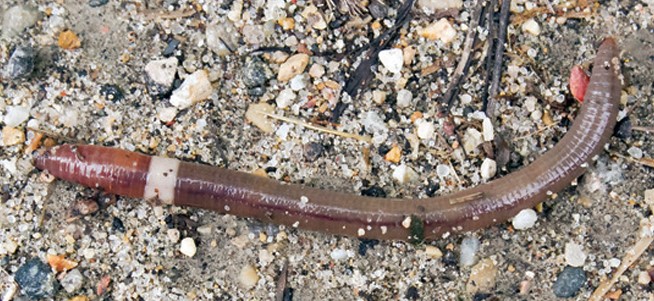Keep your eye out for this invasive species: Jumping worms
Submitted by: Cornell Cooperative Extension Madison County
Nearly all earthworms in the Northeast today are non-native, and these European and Asian invasives are altering the soil structure and chemistry of our forests. They consume the critical layer of organic matter that supplies vital nutrients for plants and provides food, protection and habitat for wildlife. However, jumping worms are especially concerning. These Asian exotics devour organic matter more rapidly than their European counterparts, stripping the forest of the layer critical for seedlings and wildflowers. Jumping worms grow twice as fast, reproduce more quickly and can infest soils at high densities. In areas of heavy infestation, native plants, soil invertebrates, salamanders, birds and other animals may decline. Jumping worms can severely damage roots of plants in nurseries, gardens, forests and turf. They, along with other invasive worms, can also help spread invasive plant species by disturbing the soil. Jumping worms are widespread across much of the Northeast, Southeast and Midwestern US, and the first records date to the late 19th century. Unfortunately, relatively little is known about them compared to European earthworms.
Where to find them?
They can be found on the soil surface and in the leaf litter, making them easy to find. They can live anywhere from urban parks and suburban backyards, to rural forests. You are very likely to find them in compost piles and along roads.
A highly invasive species
Many worm species can reproduce without mating, which means a single worm can start a whole population. Because jumping worms are more aggressive and their populations can grow faster than the common European species, they may outcompete existing worm populations. Adults die prior to winter, but their young survive harsh New York winters in tiny, resilient cocoons. Cocoons are very small and dirt colored, so they are nearly impossible to spot with your own eyes. Cocoons can be spread easily in potted plants, and on landscaping equipment, mulch, tire treads and even hiking boots.
What to look for:
Worms are smooth, glossy gray or brown; 1.5 to 8 inches long.
- Crazy behavior. They jump and thrash wildly when handled, moving more like a threatened snake. They can also shed their tails in defense.
- Clitellum (the narrow band around their body): Smooth to the body, unlike most other species which have a raised and pink-colored clitellum. Their clitellum completely encircles the body and is often cloudy-white to gray-colored. Body looks metallic.
- Soil signature: Jumping worms leave distinctive grainy soil full of worm castings. The soil becomes granular and looks like dried coffee grounds.
- Timing: Best time to find them is late August or September when they are largest.
Stop the spread
We currently have no viable earthworm control methods, but we can prevent their spread.
- Do not buy or use jumping worms for bait, vermicomposting or gardening.
- Only sell, purchase or trade compost that was heated to appropriate temperatures and duration following protocols for reducing pathogens.
- Clean compost, soil and debris from vehicles, personal gear, equipment and gardening tools before moving to and from sites.
- Dispose of all live worms in the trash or place them in a bag and leave out in the sun for at least 10 minutes, then throw the bag away.
- Be careful when sharing and moving plants. Always check for worms and know where your plantings come from. Buy bare root stock when possible.
- Check your property for earthworms using a mustard pour (it won’t harm your plants). Mix a gallon of water with 1/3 cup of ground yellow mustard seed and pour slowly into the soil. This will drive any worms to the surface. If you have jumping worms, report it and avoid moving plants or soil from your yard.
Report your sightings
If you see jumping worms, please report your sightings to nyimapinvasives.org.
Adapted from CCE fact sheet prepared by Karen Ceballos.
